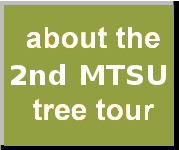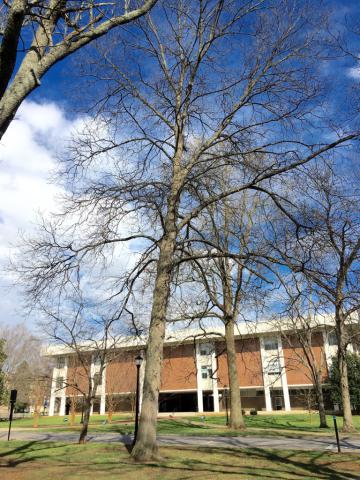
|

|

|

|
An individual instance of Carya ovata (shagbark hickory)

Permanent unique identifier for this particular organism:
http://bioimages.vanderbilt.edu/mtsu/16
Notes:
Description
A member of the walnut family, shagbark hickory is a medium-sized deciduous tree with shaggy, gray bark. Mature trees have an average height of 70-80 feet, with an oval crown and a spread of 25 to 35 feet. The leaves are alternate, pinnately compound, serrate, oblong, and lanceolate. They are approximately four to 8 inches long, green, turning yellow in the fall. Shagbark hickory has green flowers in the spring that produce oval, round fruit one to three inches that become dry and hard at maturity and split freely to the base into four valves along grooved sutures. The enclosed nut is light brownish white. The shell is relatively thin and the kernel is sweet and edible. Individual trees can live for over 300 years.
Uses
The edible nuts are produced in abundance and are used by many birds and mammals. The nuts are a preferred food of squirrels and are eaten from the time fruits approach maturity in early August until the supply is gone. Hickory nuts also are 5 to 10 percent of the diet of eastern chipmunks. In addition to the mammals above, black bears, gray and red foxes, rabbits, and white-footed mice, mallards, wood ducks, bobwhites, and wild turkey utilize small amounts of hickory nuts. Shagbark hickory nuts were traditionally a staple food for Native Americans. Shagbark hickory is also prized for its ornamental bark and its showy yellow leaf display in the fall. Along with pignut hickory (Carya glabra), shagbark hickory provides the majority of commercial hickory wood. Its wood is used primarily in furniture, flooring, and tool handles. The wood is quite tough and also resilient, which makes it ideal for products such as ladder rungs, dowels, athletic goods, and gym equipment.
Distribution and habitat
Shagbark hickory is found throughout most of the Eastern United States from southeastern Nebraska and southeastern Minnesota through southern Ontario and southern Quebec to southern Maine, southward to Georgia, Alabama, Mississippi, Louisiana, and eastern Texas, and disjunctly in the mountains of northeastern Mexico. It is largely absent from the southeastern and Gulf coastal plains and lower Mississippi Delta areas. Shagbark hickory grows best in a humid climate. It is one of the hardiest of the hickory species, however, and has successfully adapted to a wide range of climatic conditions. Sites occupied by shagbark hickory vary greatly. In the North it is found on upland (often south-facing) slopes, while farther south it is more prevalent on soils of alluvial origin. In the Ohio Valley, shagbark grows chiefly on north and east slopes of fertile uplands; in the Cumberland Mountains it is confined to the coves and the north and east slopes; and in Arkansas, Mississippi, and Louisiana it grows principally in river bottoms. Through most of its range, shagbark hickory is associated with oaks, other hickories, and various mixed upland hardwoods. In the South it is also associated with a number of bottom-land hardwood species.
References
Gilman, E.F., & Watson, D.G. (1993). Fact sheet for shagbark hickory (carya ovata). Retrieved from http://hort.ufl.edu/database/documents/pdf/tree_fact_sheets/carovaa.pdf
Graney, D.L. (2004). Shagbark hickory (carya ovata). Retrieved from http://www.na.fs.fed.us/pubs/silvics_manual/volume_2/silvics_v2.pdf

|

|
|
Load database and switch to thumbnail view
Use this stable URL to link to this page:
http://bioimages.vanderbilt.edu/mtsu/16.htm
This particular organism is believed to have managed means of establishment.
This organismal entity has the scope: multicellular organism.
Identifications:
Carya ovata
(Mill.) K. Koch
sec. Tennessee Flora 2014
common name: shagbark hickory
family: Juglandaceae
Identified 2016-03-13 by Patrick Phoebus
Location:
Alma Mater Dr, James Union Building, Rutherford County, Tennessee, US
Click on these geocoordinates to load a map showing the location: 35.8481°, -86.3699°
Coordinate uncertainty about: 10 m.
Altitude: 190 m.
Location calculated as average of its images' coordinates.
Occurrences were recorded for this particular organism on the following dates:
2016-03-13
The following images document this particular organism.
Click on a thumbnail to view the image and its metadata. Load database and enable navigation by taxon and organism.
| Image | View |

|
whole tree (or vine) - winter |
|
|
whole tree (or vine) - view up trunk |
|
|
bark - unspecified |
|
|
bark - of a large tree |